#Sensor Technology in Agriculture Market
Text
How Innovation Is Reshaping the Food Industry
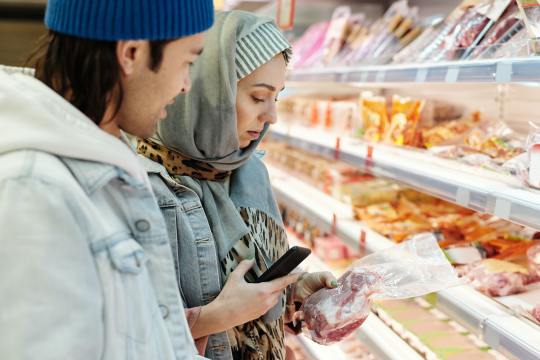
Food innovation refers to introducing novel ideas, products, and technologies that change how society produces, processes, packages, distributes, and consumes food. It goes beyond merely creating new recipes or flavors - food innovation encompasses advances in agriculture, food science, sustainability, and packaging. The goal is to enhance efficiency, safety, nutrition, and the overall consumer experience.
The need for food innovation arises from the ever-changing demands of consumers and the pressing challenges faced by the industry. As the global population continues to grow, so does the demand for food. Additionally, sustainability concerns, climate change, and limited resources prompt exploring alternative food growing and production methods. Innovations in food aim to enhance food security, minimize environmental impact, and offer consumers healthier, more diverse options.
Food innovation occurs through a combination of research, collaboration, and creativity. Scientists, entrepreneurs, farmers, and food industry professionals work together to develop new technologies and processes. Research institutions and startups play a crucial role in conducting experiments, testing new concepts, and bringing innovative products to the market.
In recent years, the food industry has witnessed groundbreaking innovations reshaping how people interact with food. The plant-based movement has gained immense traction, with plant-based alternatives for meat, dairy, and seafood becoming mainstream. Companies have developed plant-based burgers, vegan cheeses, and sustainable seafood alternatives using cutting-edge technologies. Beyond plant-based options, innovations have also focused on alternative protein sources, such as insect-based proteins and lab-grown meats, offering sustainable and protein-rich alternatives.
Swedish startup Mycorena is boosting microbial protein production through its fungi-based mycoprotein called Promyc. This ingredient can be used to create meat and tuna alternatives, beverage additives, and dessert ingredients, offering plant-based and sustainable options for consumers.
Finnish startup Onego Bio has developed a product genetically identical to egg whites using fermentation, and without using actual chickens. It uses precision fermentation of a microflora called Trichoderma reesei to produce ovalbumin, the protein found in chicken egg whites. This technology offers a sustainable and animal-friendly alternative for various food applications, including baked goods, desserts, sauces, and dressings.
Companies like New Culture are incorporating animal-free casein into their cheeses through precision fermentation. This breakthrough allows them to produce animal-free mozzarella cheese, offering a delicious and cruelty-free alternative to traditional dairy products.
In addition, consumers increasingly seek transparency in food choices, leading to the clean label movement. Brands are responding by using simple natural ingredients and avoiding artificial additives and preservatives.
Breakthrough innovations in the food industry are revolutionizing how society grows, produces, and consumes food, focusing on sustainability, nutrition, and convenience. One such innovation is plastic-free and smart packaging. Food companies are exploring biodegradable and even edible packaging solutions in response to environmental concerns. Smart packaging using nanotechnology is also gaining popularity, allowing consumers to assess food safety and quality easily.
The Internet of Things (IoT) in agriculture employs sensors and data analytics for optimizing crop conditions, irrigation, and pest control, reducing resource usage. Food waste reduction solutions, such as surplus food redistribution platforms, are being developed to combat the global food waste crisis. Moreover, biotechnology and data science advances enable personalized nutrition, tailoring dietary recommendations to individuals based on their genetic makeup, lifestyle, and health goals. These innovations promise a more sustainable, healthier, and efficient food future.
Food innovation is driving a remarkable transformation in the food industry, responding to the challenges and opportunities of today. From new plant-based products to sustainable agriculture and cutting-edge technologies, the future of food promises to be more diverse, nutritious, and sustainable. As consumers, entrepreneurs, and stakeholders continue to embrace innovation, the food industry's journey toward a more resilient and conscious future is set to continue.
13 notes
·
View notes
Text
Genio 510: Redefining the Future of Smart Retail Experiences
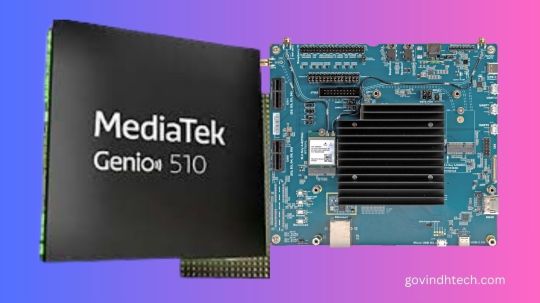
Genio IoT Platform by MediaTek
Genio 510
Manufacturers of consumer, business, and industrial devices can benefit from MediaTek Genio IoT Platform’s innovation, quicker market access, and more than a decade of longevity. A range of IoT chipsets called MediaTek Genio IoT is designed to enable and lead the way for innovative gadgets. to cooperation and support from conception to design and production, MediaTek guarantees success. MediaTek can pivot, scale, and adjust to needs thanks to their global network of reliable distributors and business partners.
Genio 510 features
Excellent work
Broad range of third-party modules and power-efficient, high-performing IoT SoCs
AI-driven sophisticated multimedia AI accelerators and cores that improve peripheral intelligent autonomous capabilities
Interaction
Sub-6GHz 5G technologies and Wi-Fi protocols for consumer, business, and industrial use
Both powerful and energy-efficient
Adaptable, quick interfaces
Global 5G modem supported by carriers
Superior assistance
From idea to design to manufacture, MediaTek works with clients, sharing experience and offering thorough documentation, in-depth training, and reliable developer tools.
Safety
IoT SoC with high security and intelligent modules to create goods
Several applications on one common platform
Developing industry, commercial, and enterprise IoT applications on a single platform that works with all SoCs can save development costs and accelerate time to market.
MediaTek Genio 510
Smart retail, industrial, factory automation, and many more Internet of things applications are powered by MediaTek’s Genio 510.
Leading manufacturer of fabless semiconductors worldwide, MediaTek will be present at Embedded World 2024, which takes place in Nuremberg this week, along with a number of other firms. Their most recent IoT innovations are on display at the event, and They’ll be talking about how these MediaTek-powered products help a variety of market sectors.
They will be showcasing the recently released MediaTek Genio 510 SoC in one of their demos. The Genio 510 will offer high-efficiency solutions in AI performance, CPU and graphics, 4K display, rich input/output, and 5G and Wi-Fi 6 connection for popular IoT applications. With the Genio 510 and Genio 700 chips being pin-compatible, product developers may now better segment and diversify their designs for different markets without having to pay for a redesign.
Numerous applications, such as digital menus and table service displays, kiosks, smart home displays, point of sale (PoS) devices, and various advertising and public domain HMI applications, are best suited for the MediaTek Genio 510. Industrial HMI covers ruggedized tablets for smart agriculture, healthcare, EV charging infrastructure, factory automation, transportation, warehousing, and logistics. It also includes ruggedized tablets for commercial and industrial vehicles.
The fully integrated, extensive feature set of Genio 510 makes such diversity possible:
Support for two displays, such as an FHD and 4K display
Modern visual quality support for two cameras built on MediaTek’s tried-and-true technologies
For a wide range of computer vision applications, such as facial recognition, object/people identification, collision warning, driver monitoring, gesture and posture detection, and image segmentation, a powerful multi-core AI processor with a dedicated visual processing engine
Rich input/output for peripherals, such as network connectivity, manufacturing equipment, scanners, card readers, and sensors
4K encoding engine (camera recording) and 4K video decoding (multimedia playback for advertising)
Exceptionally power-efficient 6nm SoC
Ready for MediaTek NeuroPilot AI SDK and multitasking OS (time to market accelerated by familiar development environment)
Support for fanless design and industrial grade temperature operation (-40 to 105C)
10-year supply guarantee (one-stop shop supported by a top semiconductor manufacturer in the world)
To what extent does it surpass the alternatives?
The Genio 510 uses more than 50% less power and provides over 250% more CPU performance than the direct alternative!
The MediaTek Genio 510 is an effective IoT platform designed for Edge AI, interactive retail, smart homes, industrial, and commercial uses. It offers multitasking OS, sophisticated multimedia, extremely rapid edge processing, and more. intended for goods that work well with off-grid power systems and fanless enclosure designs.
EVK MediaTek Genio 510
The highly competent Genio 510 (MT8370) edge-AI IoT platform for smart homes, interactive retail, industrial, and commercial applications comes with an evaluation kit called the MediaTek Genio 510 EVK. It offers many multitasking operating systems, a variety of networking choices, very responsive edge processing, and sophisticated multimedia capabilities.
SoC: MediaTek Genio 510
This Edge AI platform, which was created utilising an incredibly efficient 6nm technology, combines an integrated APU (AI processor), DSP, Arm Mali-G57 MC2 GPU, and six cores (2×2.2 GHz Arm Cortex-A78& 4×2.0 GHz Arm Cortex-A55) into a single chip. Video recorded with attached cameras can be converted at up to Full HD resolution while using the least amount of space possible thanks to a HEVC encoding acceleration engine.
FAQS
What is the MediaTek Genio 510?
A chipset intended for a broad spectrum of Internet of Things (IoT) applications is the Genio 510.
What kind of IoT applications is the Genio 510 suited for?
Because of its adaptability, the Genio 510 may be utilised in a wide range of applications, including smart homes, healthcare, transportation, and agriculture, as well as industrial automation (rugged tablets, manufacturing machinery, and point-of-sale systems).
What are the benefits of using the Genio 510?
Rich input/output choices, powerful CPU and graphics processing, compatibility for 4K screens, high-efficiency AI performance, and networking capabilities like 5G and Wi-Fi 6 are all included with the Genio 510.
Read more on Govindhtech.com
#genio#genio510#MediaTek#govindhtech#IoT#AIAccelerator#WIFI#5gtechnologies#CPU#processors#mediatekprocessor#news#technews#technology#technologytrends#technologynews
2 notes
·
View notes
Text
Wind Farms: Harvesting Energy on a Grand Scale
Wind farms represent the vanguard of renewable energy, showcasing how the forces of nature can be harnessed on a grand scale to power our cities, industries, and homes. These sprawling complexes of towering turbines are becoming an increasingly common sight across vast tracts of land and coastal areas around the world, symbolizing the shift towards sustainable energy production.
The Composition of Wind Farms
A wind farm is an assemblage of multiple wind turbines in a single location used for the production of electric power. A large wind farm may consist of several hundred individual wind turbines, and they cover an extended area of hundreds of square miles. The land between the turbines may be used for agricultural or other purposes. For instance, the Gansu Wind Farm in China stretches over 7,965 square miles, an area larger than some countries.
Site Selection: A Crucial Step
The placement of a wind farm is a meticulous process that involves consideration of wind patterns, environmental impact, and proximity to the grid. Optimal sites are usually in areas with steady, strong winds averaging at least 14 miles per hour. According to the Department of Energy (DOE), wind farms on the U.S. coasts and Great Lakes could generate more than twice the amount of electricity used by the entire country. Coastal areas have the advantage of offshore wind farms which can utilize stronger ocean winds and have less visual impact on the community.
The Technology Behind Wind Farms
Wind turbines in these farms are equipped with state-of-the-art technology to maximize efficiency and minimize downtime. Turbines are now smarter, with sensors and automated systems that adjust blade rotation and orientation to the wind for optimal energy capture. Many have a capacity of 2-3 MW each, with some of the largest offshore turbines boasting a capacity of up to 12 MW. The DOE states that a 2 MW wind turbine can supply electricity to over 500 homes.
The Economics of Wind Energy
Wind farms are economically compelling as well. The cost of wind-generated electricity has plummeted over the past decade, with the International Renewable Energy Agency (IRENA) reporting that onshore wind power is now among the cheapest sources of electricity in many parts of the world. Wind farm projects also create jobs, both in construction and maintenance; the Global Wind Energy Council (GWEC) reported that the sector employed 1.2 million people worldwide as of 2021.
Impact on the Grid and Energy Markets
Wind farms play a significant role in grid stability and energy markets. As intermittent sources, they are often backed by energy storage systems or integrated into a larger grid infrastructure that can balance supply and demand. Innovative solutions like battery storage or interconnections with other renewable sources are being developed to mitigate wind’s variability. Market-wise, the increased wind energy supply is driving down electricity costs and fostering competition among energy sources.
Environmental and Societal Considerations
While wind farms are a boon to renewable energy, they are not without their challenges. Concerns over wildlife, especially birds and bats, and noise pollution for nearby residents are significant issues that require careful planning and mitigation strategies. Nevertheless, the environmental impact is substantially lower compared to fossil fuel-based power generation. Wind farms also contribute positively to the local communities through land lease payments and increased tax revenues used for schools, roads, and healthcare services.
Looking Forward: The Evolution of Wind Energy
The future of wind farms is intertwined with advancements in technology and energy policy. Continued research in aerodynamics, materials science, and turbine design is poised to make wind energy even more efficient and less expensive. The International Energy Agency (IEA) projects that by 2040, wind and solar will power more than a third of the world, with wind energy being a significant contributor. Wind farms are not just about generating electricity; they are about reshaping our energy landscape, fostering sustainable development, and creating a blueprint for future energy solutions.
#windenergy#windgeneration#windfarms#renewableenergy#sustainability#greenenergy#cleanenergy#environment#electricity
3 notes
·
View notes
Text
The Future of Farming: Top Trends Shaping the Agritech Landscape
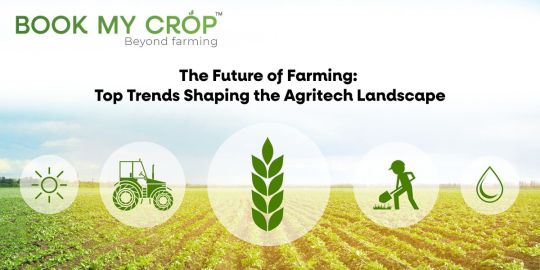
The Future of Farming: Top Trends Shaping the Agritech Landscape
The agriculture sector is undergoing profound change as a result of the rising global population and the intensification of environmental threats. Agritech, the application of technology to agricultural processes, is dramatically altering the industry's outlook for the future.Latest trends in agriculture in India like precision agriculture and vertical farming are laying the groundwork for more sustainable and resilient food systems, which in turn increases efficiency and productivity. This blog delves into the major developments that are changing the face of agritech and reshaping the future of farming.
● Precision Agriculture: Maximizing Efficiency with Data-Driven Insights
The agritech revolution is being led by precision agriculture. Farmers may maximise agricultural yields while minimising resource waste by employing cutting-edge technologies including global positioning systems (GPS), sensors, drones, and data analytics. By measuring soil moisture, for instance, farmers may irrigate just the areas that actually require it, saving water while improving plant health. Farmers' abilities to monitor crops, anticipate the weather, and prevent disease outbreaks are all strengthened by the combination of satellite imagery and machine learning algorithms.
● Vertical Farming: Cultivating Crops in Controlled Environments
With more people living in cities and less land available for farming, vertical farming is gaining popularity as a viable alternative. This cutting-edge method is cultivating plants in tiers or on inclined surfaces, most frequently in urban settings. LED lighting, hydroponic or aeroponic systems, and climate control technology all contribute to the ideal growing conditions in modern vertical farms that are considered as one of the most popular agriculture trends in India. This development not only lessens the requirement for large tracts of land, but it also lessens the expense of transportation and makes year-round production possible, guaranteeing a more reliable food supply.
● Robotics and Automation: Enhancing Productivity and Labor Efficiency
Automation and robotics are revolutionising farming operations, especially in labour-intensive and repetitive jobs. In today's farms, it's not unusual to see autonomous tractors, drones, or robotic harvesters. These innovations allow for precise seed sowing, crop health monitoring, and even selective harvesting. Farmers can better allocate resources, increase efficiency, and cut expenses by decreasing their reliance on manual labour. Cultivate the seeds of success with an AI-enabled platform that offers online agro-trade solutions. Choose one of the top online agriculture companies in India - Book My Crop for agro-trade!
● Blockchain and Traceability: Ensuring Food Safety and Transparency
More and more people are thinking about where their food comes from and how safe it is to eat. With its immutable and transparent record of each link in the food supply chain, blockchain technology provides a potential solution. Every step, from planting to harvesting to processing to distribution, is documented, making the data reliable and impossible to alter. This does double duty by improving food safety and building faith in the food industry.
● Biotechnology and Genetic Engineering: Developing Resilient Crops
Biotechnology and genetic engineering have allowed for the creation of crops with enhanced resistance to pests, diseases, and fluctuating environmental circumstances. Modifying a plant's genetic makeup can increase its nutrient content, prolong its storage life, and decrease its need for pesticides. These developments may help reduce the negative effects of climate change on agricultural output and address food security issues. Skip the market queues, choose convenience. Download Book My Crop mobile app to order agriculture produces online in India!
● Smart Water Management: Optimizing Water Usage
In many regions of the world, water scarcity is a serious problem. Monitoring and optimising water use in agriculture is made possible by smart water management systems that employ Internet of Things (IoT) devices, sensors, and data analytics. In order to select the best irrigation methods, farmers may now precisely measure soil moisture levels, weather forecasts, and plant needs. Smart water management helps with both sustainable farming and water conservation since it reduces water waste.
Final Thoughts:
Integrating technology and new methods into farming is radically altering the industry's potential future. The agritech landscape is shifting and being revolutionised by developments in areas such as precision agriculture, vertical farming, robotics, blockchain, and biotechnology. Farmers may improve productivity, lessen their effects on the environment, and help create more secure and sustainable food systems by adopting these innovations. Agritech will be crucial in assuring agriculture's continued success as we continue to deal with the effects of a rising global population and shifting climate. Book My Crop, one of the distinct Online agritech companies in India - is an excellent AI-enabled platform that is specially built to bring Indian farmers and buyers together for the agro-trade.
5 notes
·
View notes
Text
Types and 5 Most Popular for 2023
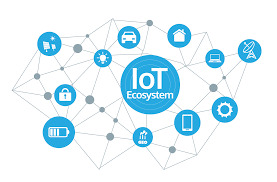
Types of IoT
Networking, communication, and connectivity systems depend on the specific IoT application being deployed. Just as there are many different IoT devices, there are many types of IoT applications depending on their use. Here are some of the more common ones:
• IoT client – intended for everyday use. Examples: home appliances, voice assistants and lighting.
• Business IoT – commonly used in the healthcare and travel industries. Examples: smart pacemakers and monitoring systems.
• Military Matters (IoMT) - Commonly used for the application of IoT technology in the military sector. Examples: surveillance robots and attack-capable objects.
• Industrial Internet of Things (IIoT) - commonly used in industrial applications, such as in manufacturing and the energy sector. Ex: Digital control systems, smart agriculture and big data industries.
• IoT Infrastructure – It is widely used for connectivity in smart cities. Example: equipment sensors and control systems.
Why is IoT important? IoT has enabled the physical world to meet the digital world in collaboration. It provides benefits to organizations by allowing them to work and simplify their work. As IoT grows exponentially year on year, businesses are taking advantage of the incredible business benefits it can deliver. Here are some of the most important benefits of IoT:
• Create new business models and revenue streams
• Improve business decisions and insights based on IoT data.
• To increase productivity and efficiency of business operations
• To improve customer experience
Although global IoT spending has been affected by the economic impact of the COVID-19 pandemic, IDC's analysis shows that it will reach a CAGR of 11.3% over the forecast period 2020-2024.
What are IoT devices?
IoT devices are hardware devices, such as sensors, appliances, devices and other machines that collect and exchange data over the Internet. They are designed for certain applications that can be connected to other IoT devices. For example, an IoT device in your car can detect oncoming traffic and send an instant message to the person you're about to see about an upcoming delay.click amazon market place.
How do IoT devices work?
Different IoT devices have different functions, but they all have similarities in terms of how they work. First, IoT devices are physical objects that see what is happening in the physical world. They have integrated processors, network cards, and hardware, and are often connected to Dynamic Host Configuration Protocol servers. It also requires an IP address to work on the network.
Many IoT devices are programmed and controlled through software. For example, an app on your smartphone to control the lights in your home. Some tools are also built into the web server, eliminating the need for external applications. For example, the light turns on immediately when you enter the room.
1 note
·
View note
Text
How Agricultural Technology is Transforming Farming and Shaping Our Future
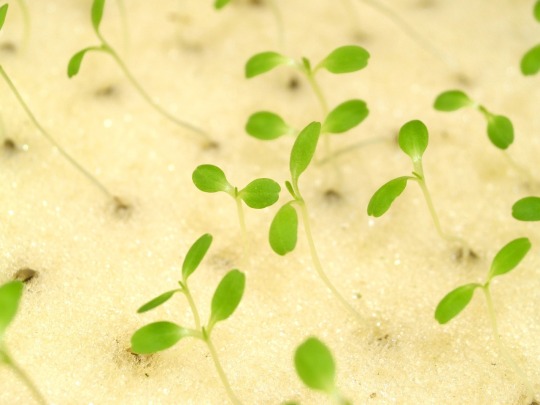
The future of agricultural technology promises to bring more efficient, effective, and even environmentally friendly farming techniques. Technology innovations are quickly advancing traditional methods of farming with robotic control systems, artificial intelligence (AI), efficient irrigation systems, and more. With these advances, farmers can expect to produce higher yields with fewer resources, plus have greater access to data-driven predictions and analytics to fine-tune their operations. The potential for agricultural technology is limitless and farmers are increasingly turning to the latest technologies to maximize their yields and guarantee a more sustainable future.
As the global population nears 8 billion people, agricultural technology is developing rapidly to meet the increasing demand for food. From gene-editing techniques, machine learning, and precision agriculture to advancements in irrigation, robotic devices and smart farming, the use of technology in agriculture is paving the way for a more sustainable future. In this blog post, we explore some of the exciting agricultural technology innovations that are propelling agricultural production higher, and how they could lead to a more efficient and sustainable future.
Gene-Editing and Its Disruptive Potential
Gene-editing is revolutionizing the way scientists and farmers design crops, augmenting natural adaptation to improve and optimize plants. Scientists are able to selectively alter the genetic code of those plants in order to boost desired traits, such as disease resistance or greater yield. CRISPR, or clustered regularly interspaced short palindromic repeats, is an efficient and precise gene-editing tool that is often utilized in laboratories, but can also be deployed in the field. As CRISPR technology continues to evolve, it is likely to have a larger impact on agricultural production.
The Benefits of Smart Irrigation
Advancements in irrigation are allowing farmers to intelligently monitor and manage their water usage. Smart irrigation systems can leverage climate data, soil sensors and precipitation forecasts to determine the optimal time and amount of water needed to nourish the crops. Automatically adjusting this depending on the changing conditions, such as temperatures and rainfall variations, is proving to be a much more effective way than traditional irrigation methods. With this added level of control, not only do farmers save water, but they also increase their crop yields and reduce input costs.
Precision Agriculture and Machine Learning
In the quest to improve agricultural production, precision agriculture is seen by many as the ultimate solution. This process involves collecting data about soil, crops, and weather and using analytical tools such as machine learning to help farmers make informed decisions. Utilizing this information can give farmers a better understanding of how crops are responding to different conditions, enabling them to quickly make better decisions on how to increase crop yield. In addition, machine learning algorithms can be used to identify yield-limiting factors such as pests or diseases, and instantly signal growers to take appropriate action.
Robots in Agriculture
The use of robots in agriculture is one of the latest innovations to hit the market. Robots can be used for tasks like crop scouting, weed management, and harvesting. They are also capable of gathering data quickly and accurately, enabling more efficient decisions to be made. While robots have a way to go before they reach full autonomy, they have already proven to be very valuable in a wide range of agricultural applications, and are likely to play an increasingly important role in the near future.
Conclusion
Agricultural technology has the potential to transform the future of farming. From gene-editing and the use of smart irrigation systems to precision agriculture and the use of robots in agriculture, the agriculture industry is on the cusp of some major breakthroughs that could drastically improve yields and reduce input costs. As technology continues to advance, it is likely that these innovations will become commonplace and result in a more sustainable and efficient future.
Agricultural technology is an ever-changing field with continual advances. With the increase in smart technology, robots and drones, farms are becoming more efficient and sustainable. The use of technology helps maximize yield, conserve resources and increase worker safety. By leveraging advanced technology, farmers now have access to a host of new strategies and processes. The future of agriculture promises to be even brighter as we enter a period of technological advancement and innovation.
Thank you for engaging in this exploration of agricultural technologies. We must continue to use it responsibly to create positive outcomes and make farming easier and more profitable in the years to come.
Learn more about agricultural technology with Taim.io
2 notes
·
View notes
Text
IoT Insurance Market - Forecast (2022 - 2027)
The Global market for Iot Insurance is forecast to reach $3,123.3 million by 2026, growing at a CAGR of 18.7% from 2021 to 2026. IoT-Connected insurance uses the data from internet-connected devices and telematics to improve the understanding of risks. It is a new approach that is based on use of sensors and digital technologies to monitor the state of an insured risk transforming rough data in usable and actionable information. Advances in IoT insurance can improve the productivity, overall profitability of the business and the risk profile of the portfolio. Through IoT, insurers can better connect with customers adding important touch points in particularly sensitive phases like acquisitions and claims. It is observed that automation can cut the cost of the claims process by as much as 30% and IoT connected devices have helped some life insurance and health insurance companies lower their premiums by as much as 25%.

Report Coverage
The report: “Iot Insurance Market– Forecast (2021-2026)”, by IndustryARC covers an in-depth analysis of the following segments of the Iot Insurance market.
By Type – Health Insurance, Life Insurance, Property and Casualty Insurance and Others.
By Application – Life and Health Insurance, Home and Commercial Buildings, Automotive and Transportation, Business and Enterprise, Consumer Electronics and Industrial Machines, Travel, Agriculture and Others.
By Geography - North America (U.S, Canada, Mexico), South America(Brazil, Argentina and others), Europe (Germany, UK, France, Italy, Spain, Russia and Others), APAC(China, Japan India, SK, Aus and Others), and RoW (Middle East and Africa)
Request Sample
Key Takeaways
Advances in IoT insurance can improve the productivity, overall profitability of the business and the risk profile of the portfolio.
IoT technology presents opportunities for insurers to reduce and mitigate losses, improve underwriting and enhance personalization of products and services.
Automation in insurance can cut the cost of claims process by as much as 30%
North-America is expected to hold a significant share in the IoT Insurance market due to growing awareness and faster adoption of IoT technology.
IoT Insurance Market Segment Analysis - By Type
The most important type of insurances are life insurance and health insurance which accounted for 44% share combined in 2020. Life insurance is something that pays out a sum of money either on the death of the insured person or after a set period. On the other hand health insurance covers the cost of hospitalization, visits to the doctor’s office and prescription medicines. The rising usage of digital technologies in this sector will drive market growth.
Inquiry Before Buying
IoT Insurance Market Segment Analysis - By Application
IoT insurance is applicable to almost all industries like automobile, manufacturing, agriculture, healthcare, hospitality, retail, finance, transportation and smart homes and buildings. Automotive industry is one of the industries most benefited after introduction of IoT. IoT devices such as in-car sensors, smartphones, and smart appliances can send insurers data on product usage and driving habits among other behaviours. In turn, this data will be fed into AI algorithms that allow insurers to offer risk based pricing and other popular services.
IoT Insurance Market Segment Analysis – By Geography
North America held the largest market share at 35% in 2020 among regional markets due to increasing awareness and rapid implementation of IoT in various industries in countries in this region. In addition, rising use of smart devices which deliver real-time insights to allow insurance companies in this region develop advanced insurance solutions. And also presence of international players in this region such as Google LLC, Microsoft Corporation, IBM and other drives the market in this region.
Schedule a Call
Iot Insurance Market Drivers
Mitigation of risk
In traditional method, insurers have used proxy data to identify the risk of loss for an asset. Internet of things (IoT) gives insurers access to real-time, individual, observable data on an asset’s risk of loss. This data is directly actionable for risk pricing and mitigation. IoT sensors monitor the behavior and actions which are causative of risk so that insurers can create algorithms based on observed behavior directly to pricing models. In this way insurers can similarly leverage this data for risk mitigation by providing timely and specific feedback to customers.
Rising demand for cloud services
The insurance industries dealing with huge volumes of sensitive data and documents are ready to integrate cloud technology in to their digital eco system. It enables insurers to use their IT resources more efficiently, reducing the cost of acquiring and maintaining infrastructure. Cloud based applications change the way of creating and delivering their products and services, managing risks and claims, collaborating with channel members and partners and communicating with customers, agents and brokers. Thus, cloud services in the insurance industry helps drive the market growth.
Buy Now
Iot Insurance Market Challenges
Data privacy and security
Data privacy and security is utmost important when it comes to technology. IoT comes along with cyber-risks, in fact, much more than any other technology. Meaningful customer engagement would require the insurer to collect and process data at each point, facilitated by IoT. Without establishing the trust it would be difficult to obtain personal data from customers. A significant amount of data is generated from the application of connected devices from wearable devices to connected homes and telematics devices in smart vehicles. Most of the customers are skeptical about their personal data remains secured and how it is utilized by insurers.
Iot Insurance Market Landscape
Product launches, acquisitions, and R&D activities are key strategies adopted by players in the Iot Insurance market. The Iot Insurance market is dominated by major companies such IBM Corporation, SAP SE, Oracle Corporation, Google Inc., Microsoft Corporation, Cisco Systems Inc., Accenture PLC, Verisk Analytics Inc., Concirrus, LexisNexis.
Acquisitions/Technology Launches/Partnerships
In Oct 2020, LexisNexis and Yonomi Smart Home have joined forces to develop an innovative turnkey home insurance internet of things (IoT) solution. It includes a smartphone app that participating policy holders can download the app which uses smartphone and device sensors to find common IoT devices in the home, which creates a data feed to LexisNexis risk sloutions.
In May 2019, Concirrus and willis Re, has entered in to strategic partnership to transform speciality re-insurance products by leveraging data from internet of things (IoT).
For more Electronics related reports, please click here
#IoT Insurance Market#IoT Insurance Market size#IoT Insurance industry#IoT Insurance Market share#IoT Insurance Market report#IoT Insurance Market price#internet of things
2 notes
·
View notes
Text
Optimizing Operations: Industrial IoT (IIoT) Strategies
Introduction
In today's rapidly evolving industrial landscape, optimizing operations is crucial for maintaining competitiveness and driving growth. Industrial Internet of Things (IIoT) strategies play a pivotal role in achieving operational excellence by leveraging data-driven insights and automation. This article explores key strategies for optimizing operations through the implementation of IIoT solutions.
Outline
Understanding Industrial IoT (IIoT)
Strategies for IIoT Implementation
Use Cases Across Industries
Benefits and Challenges
Future Trends
Conclusion
FAQS
Background
The Industrial Internet of Things (IIoT) refers to the integration of sensors, devices, and software in industrial environments to enable real-time data collection, analysis, and decision-making. IIoT empowers organizations to streamline processes, enhance efficiency, and drive innovation across various sectors.
Strategies for IIoT Implementation
Successful IIoT implementation requires careful planning and execution. Key strategies include defining clear objectives, selecting appropriate technology solutions, ensuring data security and privacy, fostering collaboration between stakeholders, and investing in workforce training and development.
Use Cases Across Industries
IIoT finds applications in diverse industries, including manufacturing, energy, healthcare, transportation, and agriculture. Use cases range from predictive maintenance and asset tracking to remote monitoring and supply chain optimization, demonstrating the versatility and impact of IIoT solutions.
Benefits and Challenges
The adoption of IIoT offers numerous benefits, such as improved operational efficiency, reduced downtime, enhanced safety, and cost savings. However, challenges such as cybersecurity risks, data interoperability issues, and integration complexities need to be addressed to maximize the potential of IIoT.
Future Trends
The future of IIoT is characterized by advancements in edge computing, artificial intelligence, digital twins, and 5G connectivity. These trends enable organizations to unlock new opportunities for innovation, agility, and resilience in an increasingly interconnected and data-driven world.
Conclusion
IIoT strategies play a critical role in optimizing operations, enabling organizations to stay competitive and responsive to market demands. By harnessing the power of IIoT, businesses can unlock new levels of efficiency, productivity, and profitability in their operations.
FAQs
Q: How can IIoT improve asset management in manufacturing? A: IIoT enables real-time monitoring of equipment health, predictive maintenance, and asset tracking, leading to optimized asset utilization and reduced downtime in manufacturing facilities.
Q: What are the cybersecurity considerations for IIoT implementation? A: Cybersecurity measures such as encryption, authentication, access control, and continuous monitoring are essential for safeguarding IIoT systems and data from potential cyber threats and breaches.
Q: How does IIoT contribute to sustainability in the energy sector? A: IIoT enables energy efficiency optimization, renewable energy integration, smart grid management, and environmental monitoring, contributing to sustainability goals and reducing carbon footprint in the energy sector.
0 notes
Text
Precision Farming Partnerships: Integrating Agricultural Inoculants into Precision Agriculture Systems
In the era of precision agriculture, where data-driven decision-making and targeted resource management reign supreme, the integration of agricultural inoculants into precision agriculture systems marks a significant stride towards sustainable and efficient crop production. As farmers seek to optimize yield potential while minimizing environmental impact, leveraging the benefits of agricultural inoculants within precision agriculture frameworks becomes a strategic imperative in the Agriculture Inoculants Market.
Precision agriculture relies on advanced technologies such as GPS, sensors, drones, and data analytics to optimize farm inputs and practices. By integrating agricultural inoculants into precision agriculture systems, farmers can harness the power of beneficial microorganisms to enhance soil fertility, promote plant health, and improve overall crop performance. This synergistic approach maximizes resource efficiency, minimizes input wastage, and fosters sustainability in the Agriculture Inoculants Market.
One of the key advantages of integrating agricultural inoculants into precision agriculture systems is the ability to deliver targeted applications based on site-specific data and crop requirements. By utilizing geospatial data on soil properties, nutrient levels, and crop health, farmers can identify areas of the field that would benefit most from inoculant application. This allows for precise placement of inoculants, ensuring optimal soil inoculation and microbial colonization, and maximizing their efficacy in enhancing nutrient uptake and promoting plant growth in the Agriculture Inoculants Market.
Furthermore, the integration of agricultural inoculants into precision agriculture systems enables real-time monitoring and adaptive management of soil and crop health parameters. By incorporating sensors and remote sensing technologies, farmers can track changes in soil moisture, nutrient levels, and pest pressures, allowing for timely adjustments in inoculant application strategies. This dynamic approach to management ensures that agricultural inoculants are applied when and where they are needed most, optimizing their impact on soil fertility and crop productivity in the Agriculture Inoculants Market.
Moreover, the utilization of data analytics and predictive modeling in precision agriculture systems enhances the decision-making process regarding inoculant selection, dosage, and application timing. By analyzing historical data on soil health, weather patterns, and crop performance, farmers can make informed decisions on the most effective inoculant formulations and application rates for their specific agronomic conditions. This data-driven approach minimizes guesswork and maximizes the likelihood of success in integrating agricultural inoculants into precision agriculture systems in the Agriculture Inoculants Market.
Collaborations between agricultural input suppliers, technology providers, and agronomic experts play a vital role in driving the integration of agricultural inoculants into precision agriculture systems. By pooling resources and expertise, stakeholders can develop innovative solutions and customized services that meet the unique needs of farmers adopting precision agriculture practices. This collaborative approach fosters the development of integrated platforms and decision support tools that streamline the incorporation of agricultural inoculants into precision agriculture systems, driving adoption and market growth in the Agriculture Inoculants Market.
In conclusion, integrating agricultural inoculants into precision agriculture systems represents a synergistic approach to optimizing soil fertility, enhancing crop productivity, and promoting sustainability in modern agriculture. By leveraging advanced technologies, data analytics, and collaborative partnerships, farmers can harness the full potential of agricultural inoculants to achieve precision-driven outcomes in crop production. As precision agriculture continues to evolve, the Agriculture Inoculants Market stands poised to play a central role in shaping the future of sustainable and efficient farming practices.
0 notes
Text
Pioneering Tomorrow: The Future of Agricultural Inoculants
In the dynamic landscape of modern agriculture, where sustainability and innovation intersect, the future of agricultural inoculants holds immense promise. These microbial formulations, meticulously designed to enhance soil fertility and promote plant health, are poised to revolutionize farming practices and drive market growth in the Agricultural Inoculants Market. As we explore emerging trends and innovations, it becomes clear that agricultural inoculants are at the forefront of sustainable agriculture's evolution.
The Agricultural Inoculants Market is witnessing a paradigm shift towards precision agriculture, driven by advancements in technology and data-driven decision-making. Innovations such as precision application methods, sensor technologies, and digital farming platforms enable farmers to optimize the use of agricultural inoculants, ensuring targeted delivery and maximum efficacy. By leveraging real-time data on soil health, crop performance, and environmental conditions, farmers can tailor inoculant applications to specific crop needs, enhancing productivity and sustainability in the Agricultural Inoculants Market.
Furthermore, the future of agricultural inoculants lies in the development of novel formulations and microbial consortia tailored to address specific agronomic challenges. Researchers are exploring the vast biodiversity of soil microbial communities to identify beneficial strains with unique traits, such as stress tolerance, nutrient solubilization, and disease suppression. By harnessing the power of microbial diversity, scientists can engineer custom-tailored inoculants capable of delivering multiple benefits simultaneously, driving innovation and market growth in the Agricultural Inoculants Market.
The integration of omics technologies, such as genomics, transcriptomics, and metabolomics, is revolutionizing the development and optimization of agricultural inoculants. By deciphering the genetic makeup and metabolic pathways of beneficial microorganisms, researchers can gain insights into their functions, interactions, and environmental responses. This knowledge enables the targeted selection and engineering of microbial strains with enhanced traits, paving the way for next-generation inoculants with superior efficacy and versatility. As omics-driven research accelerates, the Agricultural Inoculants Market stands to benefit from a new era of precision and innovation.
In addition to technological advancements, collaborations between academia, industry, and agricultural stakeholders are driving research and development initiatives aimed at addressing key challenges and expanding market outreach. By fostering interdisciplinary partnerships and knowledge exchange, researchers can leverage diverse expertise to accelerate innovation and commercialization of agricultural inoculants. Moreover, collaborations enable the validation of inoculant efficacy under diverse agroecological conditions, ensuring their applicability and scalability in different agricultural settings. As collaborations flourish, the Agricultural Inoculants Market is poised for continued growth and transformation.
The future of agricultural inoculants also intersects with broader trends in sustainable agriculture, such as regenerative farming practices, carbon farming, and circular economy principles. By enhancing soil health, nutrient cycling, and ecosystem resilience, agricultural inoculants play a vital role in promoting regenerative agriculture, which aims to restore and enhance natural ecosystems while meeting food production needs. Moreover, the use of agricultural inoculants in carbon farming initiatives, such as cover cropping and agroforestry, contributes to carbon sequestration and climate change mitigation, aligning with global efforts to combat climate change. As sustainability becomes increasingly integral to agricultural practices, the Agricultural Inoculants Market is positioned to play a central role in shaping the future of food production.
In conclusion, the future of agricultural inoculants is characterized by innovation, collaboration, and sustainability. From precision agriculture technologies to omics-driven research and regenerative farming practices, the Agricultural Inoculants Market is evolving to meet the demands of a rapidly changing world. As farmers seek sustainable solutions to enhance soil health, improve crop productivity, and mitigate environmental impact, agricultural inoculants stand poised to lead the way towards a more resilient and regenerative agricultural future.
0 notes
Text
Green Horizon: Exploring the Biodegradable Packaging Market

"Biodegradable Packaging Market to grow at highest pace owing to rising environmental concerns"
The biodegradable packaging market has seen significant growth in recent years due to the rising environmental concerns among consumers and governments across the globe. Biodegradable packaging is manufactured using materials that can be broken down naturally by microorganisms in the environment. Plant-based materials such as paper, pulp & paper, and bagasse are widely used for manufacturing biodegradable packaging products. The sustainability and decomposability of these materials have prompted their increased adoption in the packaging industry. The biodegradable packaging finds application in food & beverage, healthcare, personal care & cosmetics, and homecare industries. Sustainable and eco-friendly properties of biodegradable packaging help brands create a positive brand image and gain new customers.
The Global biodegradable packaging market is estimated to be valued at US$ 37,919.7 Mn in 2024 and is expected to exhibit a CAGR of 20% over the forecast period 2023 to 2030.
Key Takeaways
Key players operating in the biodegradable packaging are BASF SE, Smurfit Kappa Group, Mondi Group, Rocktenn, Stora Enso, Clearwater Paper Corporation, Amcor, Novamont S.P.A., Kruger Inc., Reynolds Group Holding Limited, and International Corp. Key players are investing heavily in R&D activities to develop novel and innovative biodegradable packaging solutions. For instance, BASF has developed Ecovio, a biodegradable plastic made from renewable resources.
The rising environmental concerns and stringent regulations on single-use plastic are fueling the demand for biodegradable packaging globally. Various governments across the world have either banned or imposed levies on conventional plastic usage. This is prompting brands and retailers to shift toward sustainable biodegradable packaging alternatives.
Technological advancement in bioplastics production is augmenting the growth of the biodegradable packaging market. Major players are developing advanced bioplastics using agricultural waste and renewable resources. Emerging production technologies enable large-scale and cost-effective manufacturing of bioplastics.
Market Trends
Growing adoption of bio-based materials - With the increasing focus on sustainability, bio-based materials derived from agricultural residues are gaining traction in the packaging industry. Major players are leveraging bio-based feedstocks like lignin, cellulose, and vegetable oils for packaging production.
Personalized and smart packaging - Technological advancement is enabling innovative packaging solutions. Players are offering personalized and smart packaging integrated with sensors, RFID, and IoT for enhanced consumer experience and supply chain control.
Market Opportunities
E-commerce industry growth - The burgeoning e-commerce industry worldwide presents significant opportunities for biodegradable packaging manufacturers. Sustainable packaging plays a vital role in delivering positive brand perception.
Medical and pharmaceutical packaging - Bio plastics and paper find wide usage in healthcare packaging for sterile medical devices and pharmaceutical products. Their biodegradable properties ensure safe disposal of expired/unused medical items.
Impact of COVID-19 on Biodegradable Packaging Market Growth
0 notes
Text
Revolutionising Agriculture with IoT Technology
Written By: Jagriti Shahi
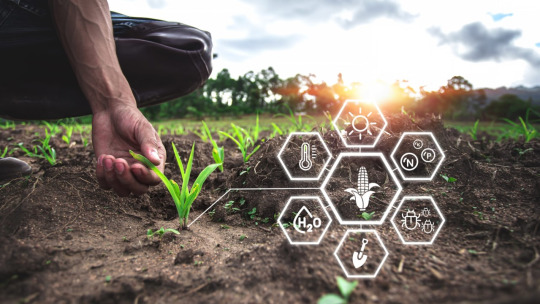
Introduction:
In recent years, the agricultural sector has undergone a profound digital transformation, propelled by the integration of Internet of Things (IoT) technology. This revolutionary shift has transcended traditional farming practices, empowering growers with real-time data and insights to make informed decisions, optimise resource utilisation, and maximise yields. By interconnecting physical devices and sensors with cloud computing and data analytics, IoT has ushered in a new era of precision agriculture, offering solutions to age-old challenges faced by farmers worldwide.
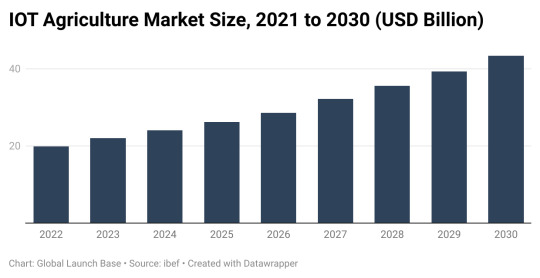
Figure: IOT Agriculture Market Size, 2021 to 2030 (USD Billion)
From the above figure we can see that IOT agriculture market size to surpass US$ 43.37 Bn by 2030
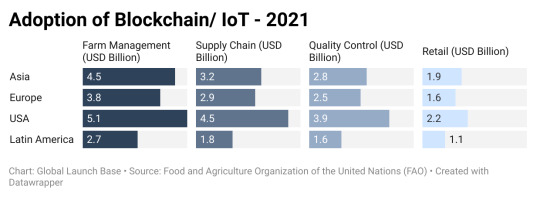
Figure: Adoption of Blockchain/ IoT - 2021
The marriage of IoT technology with agriculture has unlocked a plethora of opportunities across the entire farming ecosystem, from field management to supply chain logistics. This convergence has not only improved operational efficiency but also paved the way for sustainable farming practices. As the world grapples with escalating food demand, water scarcity, and environmental degradation, IoT-enabled solutions have emerged as indispensable tools in mitigating these challenges while ensuring food security and environmental stewardship.
Precision Farming:

Figure - Precision Farming
One of the cornerstone applications of IoT in agriculture is precision farming, which represents a paradigm shift from traditional blanket approaches to site-specific management. This innovative approach harnesses the power of IoT-enabled sensors, drones, and autonomous machinery to monitor and manage various aspects of crop production with unparalleled accuracy.
IoT sensors embedded in the soil continuously gather data on key parameters such as moisture levels, temperature, nutrient content, and pH levels. This real-time data is then transmitted to centralised platforms where it is analysed and processed using advanced algorithms. By leveraging this granular information, farmers can precisely tailor their irrigation, fertilisation, and pest control strategies to meet the specific needs of each crop and microenvironment within their fields.
Furthermore, the integration of IoT technology with precision agriculture has facilitated the development of variable rate application (VRA) systems. These systems utilise GPS-guided machinery to deliver inputs, such as water and nutrients, in precise quantities and locations based on the spatial variability detected in the field. By optimising input usage in this manner, farmers can not only enhance crop productivity and quality but also reduce costs and minimise environmental impact by avoiding over-application of inputs in areas where they are not needed.
Moreover, the data-driven insights generated through precision farming practices enable farmers to implement proactive measures to mitigate risks and optimise resource allocation. For instance, predictive analytics algorithms can forecast crop yields, pest outbreaks, and weather patterns, empowering farmers to make preemptive decisions to safeguard their crops and maximise profitability.
Overall, precision farming powered by IoT technology represents a quantum leap in agricultural productivity and sustainability. By harnessing the power of data-driven decision-making and precision management practices, farmers can unlock new levels of efficiency, profitability, and environmental stewardship in their operations. As IoT continues to evolve and become more accessible, the potential for innovation and transformation in agriculture is virtually limitless.
Smart Irrigation Systems:
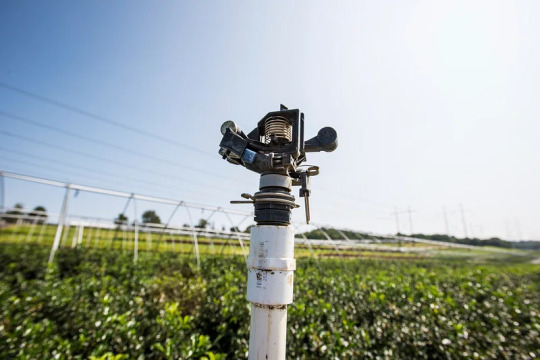
Figure: Smart Irrigation Systems
Water scarcity is a pressing concern for farmers worldwide, exacerbated by climate change and population growth. In response to this challenge, smart irrigation systems have emerged as a game-changing solution, leveraging IoT technology to optimize water usage in agricultural fields.
At the heart of smart irrigation systems are IoT-enabled sensors that continuously monitor soil moisture levels, weather conditions, and crop water requirements in real-time. These sensors transmit data wirelessly to a central control system, where advanced algorithms analyse the information and determine the precise amount and timing of irrigation needed for each area of the field.
By dynamically adjusting irrigation schedules based on actual field conditions, smart irrigation systems minimise water wastage while ensuring that crops receive the optimal amount of moisture for healthy growth. This targeted approach not only conserves water but also enhances crop yield and quality by avoiding both under- and over-irrigation, which can lead to stress, disease, and reduced productivity.
Furthermore, smart irrigation systems offer farmers unprecedented control and flexibility over their irrigation practices. Through mobile or web-based applications, farmers can remotely monitor and manage their irrigation systems from anywhere, allowing them to respond quickly to changing weather patterns or crop needs. Some advanced systems even integrate weather forecasts and soil moisture data to automatically adjust irrigation schedules, further streamlining water management and reducing manual intervention.
Beyond water conservation and crop productivity, smart irrigation systems also deliver significant economic and environmental benefits. By reducing water usage and energy consumption associated with pumping, farmers can lower their operational costs and mitigate their carbon footprint. Additionally, by minimising runoff and leaching of nutrients and agrochemicals into water bodies, smart irrigation systems help protect water quality and preserve fragile ecosystems.
Crop Monitoring and Management:
In the realm of modern agriculture, crop monitoring and management have been revolutionised by the integration of Internet of Things (IoT) technology. With the aid of IoT-enabled sensors, drones, and data analytics platforms, farmers now have unprecedented visibility into the health, growth, and condition of their crops, enabling them to make informed decisions and optimise production practices.
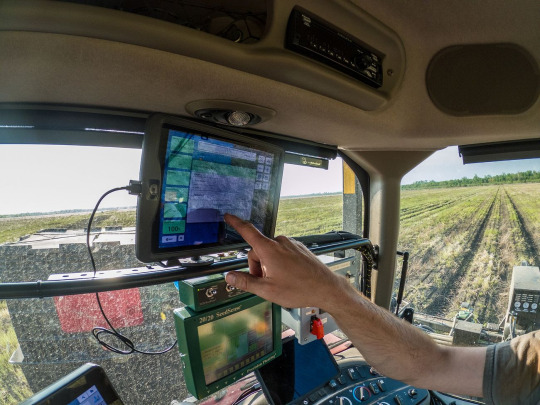
IoT sensors deployed in the field collect a wealth of data on various parameters such as soil moisture, temperature, humidity, nutrient levels, and crop health indicators. This data is transmitted in real-time to centralised platforms where it is processed and analysed using advanced algorithms. By harnessing the power of big data analytics and machine learning, farmers can derive actionable insights from this data, allowing them to monitor crop performance, detect anomalies, and identify potential issues before they escalate.
Drones equipped with high-resolution cameras and multispectral imaging sensors play a pivotal role in crop monitoring and management. These aerial platforms can capture detailed imagery of fields from above, providing farmers with valuable insights into crop health, growth patterns, and pest infestations. By analysing these images, farmers can pinpoint areas of stress or vegetation anomalies, enabling them to take targeted corrective actions such as adjusting irrigation or applying pest control measures.
Moreover, IoT technology enables the development of predictive analytics models that forecast crop yields, disease outbreaks, and pest infestations based on historical data and real-time observations. By leveraging these predictive insights, farmers can proactively plan their planting, harvesting, and pest management strategies to optimise yields and minimise losses.
Additionally, IoT-enabled crop monitoring systems offer farmers greater flexibility and scalability in their operations. These systems can be tailored to meet the specific needs of different crops, growing conditions, and farming practices, allowing farmers to optimise resources and maximise profitability. Furthermore, the integration of IoT with other emerging technologies such as artificial intelligence and robotics holds the promise of further enhancing crop monitoring and management capabilities, paving the way for more autonomous and efficient farming practices.
Overall, IoT technology has transformed crop monitoring and management from a labour-intensive and resource-intensive process into a data-driven and proactive endeavour. By providing farmers with real-time insights, predictive analytics, and actionable recommendations, IoT-enabled solutions empower farmers to optimise crop yields, reduce risks, and enhance sustainability in agriculture. As IoT continues to evolve and become more accessible, the potential for innovation and transformation in crop monitoring and management is virtually limitless.
Livestock Monitori
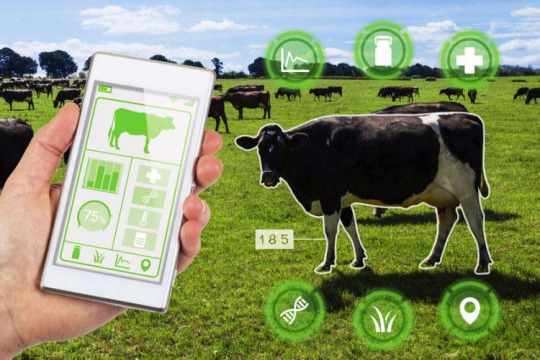
Figure: Livestock Monitoring
In the realm of modern agriculture, livestock monitoring has undergone a paradigm shift with the advent of Internet of Things (IoT) technology. Traditionally, livestock management relied heavily on manual observation and intuition, making it challenging for farmers to detect health issues, optimise feeding regimes, and maximise productivity. However, IoT-enabled sensors and data analytics platforms have revolutionised livestock monitoring, offering farmers unprecedented insights into the health, behaviour, and performance of their animals. IoT sensors, attached to animals or installed in their living environments, continuously collect data on key parameters such as body temperature, heart rate, activity levels, and rumination patterns. This real-time data is transmitted wirelessly to centralised platforms where it is analysed and processed using advanced algorithms. By monitoring these physiological and behavioural indicators, farmers can detect signs of illness, stress, or reproductive cycles early on, allowing them to intervene promptly and provide appropriate care.
Moreover, IoT technology enables farmers to track the location and movement of livestock, particularly in extensive grazing systems or large-scale operations. GPS-enabled tracking devices attached to animals provide real-time information on their whereabouts, allowing farmers to monitor grazing patterns, prevent livestock theft, and optimise pasture management. This enhanced visibility into animal behaviour and movement enables farmers to make data-driven decisions to improve herd health, productivity, and welfare.
Furthermore, IoT-enabled livestock monitoring systems offer farmers greater efficiency and scalability in their operations. These systems can be integrated with other farm management software, such as feed management or reproductive tracking systems, to provide a comprehensive view of herd performance and profitability. Additionally, the use of wearable devices and smart collars allows farmers to remotely monitor individual animals or entire herds from anywhere, reducing the need for manual labour and improving overall productivity.
In addition to improving animal health and welfare, IoT-enabled livestock monitoring systems also deliver significant economic and environmental benefits. By optimising feeding regimes and managing herd health more effectively, farmers can reduce feed wastage, minimise veterinary costs, and increase overall profitability. Moreover, by minimising the environmental impact of livestock production through more efficient resource utilisation and waste management, IoT technology contributes to the sustainability of agriculture.
Supply Chain Optimization:
In the dynamic landscape of agriculture, supply chain optimization has emerged as a critical area where Internet of Things (IoT) technology is driving significant transformation. From farm to fork, the agricultural supply chain encompasses a complex network of processes, stakeholders, and resources. IoT-enabled solutions offer unprecedented visibility, traceability, and efficiency across this entire ecosystem, revolutionising how agricultural products are produced, processed, and distributed.
At the farm level, IoT sensors deployed in fields and orchards collect data on environmental conditions, crop growth stages, and harvest readiness. This real-time data enables farmers to optimise planting schedules, manage inputs more efficiently, and anticipate yield fluctuations. By integrating IoT data with farm management systems, farmers can make data-driven decisions to maximise productivity while minimising costs and environmental impact.
As agricultural products move through the supply chain, IoT technology plays a crucial role in ensuring product quality, safety, and compliance. Temperature, humidity, and location sensors embedded in storage facilities, transportation vehicles, and processing plants monitor the conditions of perishable goods in real-time. Any deviations from optimal conditions trigger alerts, allowing stakeholders to take corrective action to prevent spoilage, contamination, or quality degradation. By maintaining the integrity of the cold chain and reducing food waste, IoT-enabled supply chain solutions contribute to improved food safety and sustainability.
Moreover, IoT technology enhances transparency and traceability throughout the agricultural supply chain, enabling stakeholders to track the journey of products from farm to consumer. Blockchain-based platforms leverage IoT data to create immutable records of product origin, production practices, and handling procedures. This transparency builds trust among consumers, enhances brand reputation, and facilitates compliance with regulatory requirements such as food safety standards and sustainability certifications.
Additionally, IoT-enabled supply chain solutions offer opportunities for optimization and cost savings through predictive analytics and automation. By analysing historical data and real-time insights, predictive analytics models can forecast demand, optimise inventory levels, and streamline logistics operations. Autonomous vehicles and robotic systems equipped with IoT sensors and artificial intelligence algorithms further enhance efficiency by automating tasks such as harvesting, sorting, and packaging.
Furthermore, IoT technology facilitates collaboration and coordination among supply chain partners through real-time data sharing and communication. Cloud-based platforms and mobile applications enable seamless integration and exchange of information between farmers, suppliers, distributors, and retailers. This collaboration fosters greater agility, responsiveness, and resilience in the face of supply chain disruptions such as weather events, market fluctuations, or global pandemics.
Advanced IoT Applications for Farms

1. Drone-based scouting and spraying: Imagine agile drones equipped with high-resolution cameras and multispectral sensors. These can autonomously map fields, identify weeds and pests with incredible accuracy, and deliver targeted treatment exactly where it's needed. This reduces reliance on broad-spectrum pesticides, promotes sustainable practices, and minimises environmental impact.
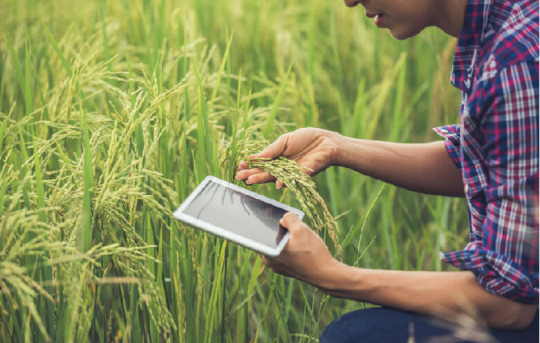
2. Predictive analytics for disease and pest control: IoT sensors combined with advanced AI can analyse historical data and weather patterns to predict outbreaks of diseases and pests. This allows farmers to take preventive measures, such as applying natural deterrents or introducing beneficial insects, before problems escalate.
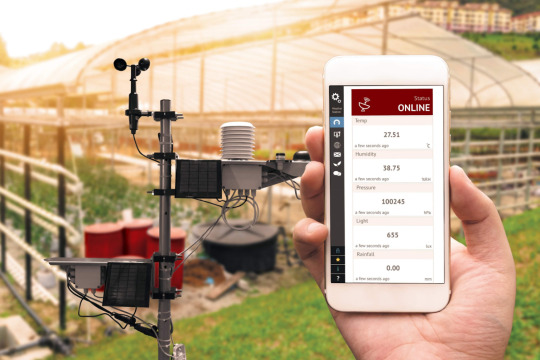
3. Climate-smart agriculture: IoT weather stations with advanced sensors can provide hyper-local weather data, including real-time wind speed, precipitation forecasts, and even data on micronutrient levels in the atmosphere. This empowers farmers to make informed decisions about planting schedules, crop selection, and irrigation strategies based on real-time forecasts, optimising yields and building resilience against climate variations.
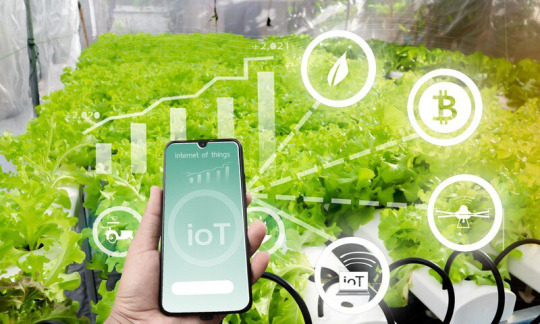
4. Blockchain for traceability and transparency: Imagine a system where every step of a product's journey, from farm to fork, is recorded on a secure blockchain ledger. Sensors embedded in packaging can monitor temperature and storage conditions during transportation, ensuring food safety. Consumers can then scan a QR code and access a transparent record of the product's origin, farming practices used, and even the environmental impact of its production.

5. Robotics for controlled-environment agriculture (CEA): In indoor farms and vertical farming facilities, IoT plays a central role. Robots equipped with sensors and grippers can perform delicate tasks like seeding, transplanting, and harvesting with minimal damage to crops. This not only reduces labour costs but also ensures consistent quality and higher yields in controlled environments.
Cultivating Innovation with IoT
The agricultural IoT revolution isn't just a theoretical concept – it's being driven by a wave of forward-thinking companies developing cutting-edge solutions. Here are a few industry leaders to watch:
Deere & Company: A major player in agricultural machinery, Deere offers a suite of IoT-powered solutions under the John Deere® FarmSight® banner. These include yield monitors, tractor telematics, and weather data analysis tools, empowering farmers to optimise their operations.
Trimble Inc.: This company provides a range of advanced positioning and data management solutions for agriculture. Their offerings include automated guidance systems for tractors and combines, allowing for high-precision planting and harvesting, and software platforms that integrate data from various sources to give farmers a comprehensive view of their operations.
SenseFly (Parrot Group): Specialises in agricultural drone technology. Their drones equipped with high-resolution cameras and multispectral sensors, are used for field scouting, identifying crop health issues, and creating detailed 3D field maps.
InFarm: A leader in the indoor vertical farming space, InFarm leverages IoT sensors and automation extensively. Their vertical farms are equipped with environmental control systems that optimise light, temperature, and humidity for specific crops, all monitored and managed through a central IoT platform.
Challenges and Future Outlook:
While the potential of IoT in agriculture is undeniable, there are challenges that need to be addressed for widespread adoption. Here's a look at some key hurdles and how we can work towards a future where smart farming flourishes:
Challenges:
Connectivity: Reliable internet access in rural areas is crucial for real-time data collection and analysis. Efforts are underway to expand broadband access and explore alternative low-power wide-area networks (LPWAN) for improved connectivity in remote locations.
Cost: The upfront investment in sensors, devices, and software can be significant, especially for small and medium-scale farms. Government subsidies, innovative financing models, and standardisation of technologies can help bring down costs and make these solutions more accessible.
Data Security and Privacy: As farms become increasingly reliant on data, robust cybersecurity measures are essential to protect sensitive information from breaches and ensure farmer trust.
Digital Literacy: Equipping farmers with the skills to understand and utilise IoT technologies effectively is crucial. Training programs, workshops, and user-friendly interfaces can bridge the digital divide and empower farmers to harness the full potential of these tools.
Future Outlook:
Despite these challenges, the future of IoT in agriculture is bright. As technology costs decrease, connectivity improves, and farmers become more comfortable with digital tools, adoption is expected to accelerate. Here are some exciting possibilities to look forward to:
Integration of AI and Machine Learning: Advanced analytics will extract even deeper insights from agricultural data, allowing for predictive maintenance of equipment, automated disease and pest control, and hyper-personalised crop management strategies.
Rise of Agtech Startups: A growing number of innovative startups are developing niche solutions tailored to specific agricultural needs. This will lead to a more diverse and dynamic ecosystem, offering farmers a wider range of choices.
Focus on Sustainability: IoT will play a key role in optimising water usage, minimising fertiliser application, and reducing the environmental impact of agriculture. This will contribute to a more sustainable food production system.
In conclusion, IoT holds immense potential to transform agriculture. By addressing the existing challenges and fostering collaboration between farmers, technology providers, and policymakers, we can usher in an era of smart farming that is not only productive but also sustainable and resource-efficient.
— x —
Global Launch Base helps international startups expand in India. Our services include market research, validation through surveys, developing a network, building partnerships, fundraising, and strategy revenue growth. Get in touch to learn more about us.
Contact Info:
Website: www.globallaunchbase.com
LinkedIn: https://www.linkedin.com/company/globallaunchbase/
Email: [email protected]
#AgriTechCEO hashtag#IoTAgricultureLeader hashtag#SmartFarmingPioneer#hashtag#PrecisionAgVisionary hashtag#DigitalAgChampion hashtag#FarmTechInnovator#IoTAgRevolutionary hashtag#AgriInnovationCEO hashtag#FutureFarmingExpert#AgriTechTrailblazer hashtag#SustainableAgLeader hashtag#DataDrivenAgCEO#AgriTechDisruptor hashtag#IoTAgSolutionist hashtag#FarmTechVisionary#AgriDigitalTransformationLeader hashtag#IoTAgriInnovator#AgriTechGameChanger hashtag#SmartAgPioneer hashtag#IOT hashtag#Agriculture
0 notes
Text
Global Smart Water Management Market Outlook: Embracing Technological Innovations from 2024 to 2032
The smart water management market encompasses a range of technologies and solutions aimed at optimizing the usage, distribution, and conservation of water resources through data-driven insights and automation. This industry has witnessed significant growth in recent years, driven by increasing water scarcity concerns, aging water infrastructure, and the need for more efficient water management practices.
Smart water management systems leverage various technologies such as IoT sensors, data analytics, cloud computing, and machine learning algorithms to monitor water quality, detect leaks, optimize irrigation, and improve overall water distribution efficiency. These systems enable utilities, municipalities, industries, and agriculture to better manage their water resources, reduce operational costs, and mitigate risks associated with water shortages and pollution incidents.

Key growth factors in the smart water management market include:
· Water Scarcity Concerns: Growing global population and urbanization are putting strain on existing water supplies, driving the need for more efficient water management solutions.
· Regulatory Compliance: Increasing regulatory mandates for water conservation, pollution control, and infrastructure upgrades are incentivizing the adoption of smart water management technologies.
· Aging Infrastructure: Many water distribution systems worldwide are old and prone to leaks and inefficiencies, prompting investments in smart technologies to improve infrastructure monitoring and maintenance.
· Advancements in IoT and Sensor Technologies: The proliferation of IoT devices and sensors enables real-time monitoring of water quality, pressure, and flow rates, facilitating proactive decision-making and resource optimization.
· Data Analytics and AI: The use of advanced analytics and AI algorithms allows for predictive maintenance, anomaly detection, and optimization of water distribution networks, leading to improved operational efficiency.
Top Companies are:
· ABB Ltd
· GE DIGITAL
· Arad Group
· IBM Corporation
· Evoqua Water Technologies LLC
· Honeywell International Inc
· Itron, Inc
· Siemens
· Schneider Electric
· Sensus
Market Segmentations:
By Meter Type (2024–2032)
AMR
AMI
By End-user (2024–2032)
Industrial
Commercial
Residential
By Technology (2024–2032)
IoT
AI
Big Data & Analytics
Cloud Computing
Regional Analysis:
Asia Pacific stands out as a dominant force in the smart water management market, showcasing robust growth trends expected to persist in the coming years. The region’s prominence stems from its vibrant industrial landscape, characterized by bustling manufacturing and assembly hubs that exhibit significant water usage. Moreover, the stringent governmental policies in select Asian nations aimed at mitigating carbon emissions and curbing water pollution further bolster market prospects. As a result, Asia Pacific emerges as a pivotal arena for smart water management solutions, poised to witness sustained expansion driven by the imperative for sustainable water resource management amidst burgeoning industrial activities and environmental consciousness.
Key highlights of the report include:
1. The report delivers thorough Market analysis, furnishing valuable insights to guide strategic decision-making.
2. The comprehensive research outlined in the study enhances the depth of your presentations and marketing strategies.
3. By offering crucial insights into key market competitors, the study empowers businesses with a strategic edge.
4. It delivers a precise assessment of evolving market dynamics, ensuring readers stay abreast of the latest industry trends.
5. With meticulous breakdowns of various market niches, the report facilitates informed decision-making processes.
0 notes
Text
How Drones Enhance Crop Monitoring and Yield Optimization in Agriculture
How Drones Enhance Crop Monitoring and Yield Optimization in Agriculture
Traditional farming methods have been completely transformed by the introduction of new technologies in recent years. Drones are one example of a technical marvel that has recently attracted considerable attention. Rapid advancements in crop monitoring and production optimisation are being made possible by these unmanned aerial vehicles. Drone applications in farming are becoming increasingly important for modern farmers thanks to the data they collect and the insights they provide.
Tomato cultivation in India holds significant economic importance, contributing to both domestic consumption and exports. Pests, diseases, and erratic weather all pose threats to crop production that reduce yield and quality. Drones are revolutionising the tomato farming industry in several ways. Drones with high-tech sensors keep an eye on crops, allowing for early detection of any problems. A higher harvest is possible with better irrigation and nutrient management made possible by accurate data. In addition, pesticide use can be reduced with the help of drones because they give key data for targeted pest control. Indian tomato producers are increasing efficiency, sustainability, and crop yield with the help of drones to supply both domestic and international markets.
This blog will explore how drones are changing agricultural practices such as crop monitoring and optimising yields.
● Precision Farming with Aerial Imaging:
Drones in Agriculture areequipped with high-resolution cameras and multispectral sensors to provide farmers with a bird's-eye view of their fields. This vantage point from above allows for an in-depth analysis of crop vitality, development trends, and problems. Drones are able to detect even minute differences in plant health by taking pictures at multiple wavelengths. This information is helpful for farmers since it allows for the early diagnosis of pests, illnesses, nutritional deficits, and water stress.
● Efficient Pest and Disease Management:
Significant yield losses can occur when crops are damaged by pests and diseases. Drones are really useful in spotting these problems early on before they worsen. Drones with cutting-edge imaging equipment may pinpoint problem areas and drop off precisely calibrated doses of insecticide, eliminating the need for widespread spraying. This has multiple benefits, including less waste and less strain on the environment and your time and money.
● Optimized Irrigation Practices:
In the agricultural sector, water scarcity is a major issue. In order to overcome this obstacle, drones can measure soil moisture levels in various parts of a field. Drones' ability to produce accurate heat maps has helped farmers fine-tune their irrigation methods to meet specific crop needs. This prevents water waste from over-irrigation and encourages stronger plant development. Harness the power of the AI-enabled platform - Connect with Book My Crop - one of the top online agriculture companies in India for smarter agro-trade!
● Crop Health Monitoring and Nutrient Management:
Drones with multispectral and hyperspectral sensors can monitor crop health and adjust nutrient levels by analysing the wavelengths of light reflected by the crop. By understanding where their crops may be lacking in nutrients, farmers may better target their fertiliser applications. Farmers may maximise production and quality by giving their crops the correct nutrients at the correct times.
● Yield Estimation and Harvest Planning:
The ability to accurately forecast crop yields is crucial for making informed marketing and harvest preparation decisions. By measuring plant density, plant height, and canopy cover, drones improve the precision of yield estimation. Insights like these help farmers maximise productivity and minimise waste by pinpointing exactly when to harvest various parts of their farms.
● Data-Driven Decision Making:
Drones collect a treasure trove of useful information that gives farmers more agency. Farmers may benefit greatly from data analytics and remote sensing technology in terms of understanding how their crops are doing and how their fields are looking. Increased yields and profits can be achieved through the use of this data to guide decisions about crop rotation, seed selection, and general land management. Healthy, natural, accessible - Shop for the finest agriculture produces online in India only at Book My Crop!
● Reduced Labor and Costs:
Monitoring crops has historically required time-consuming and labour-intensive trips to the field and the collecting of data by hand. Drones can do much of this laborious labour for farmers, saving them time and money. Drones also help farmers save money on fertilisers, herbicides, and water by allowing for more precise interventions and better utilisation of available resources.
Final Thoughts:
Drones are at the vanguard of a technological revolution in the agricultural economy. In order to optimise agriculture yields, these multipurpose UAVs are improving crop monitoring, pest management, irrigation methods, and more. Drones are altering contemporary agricultural practices by giving farmers access to real-time, data-driven insights. Drones will play an increasingly important role in encouraging sustainable and efficient farming practices and feeding the world's growing population as technology advances and becomes more widely available. Embracing drone technology is a step towards a more productive and sustainable agriculture sector, not just a step into the future. With digital tools for agricultural excellence, optimize your operations with Book My Crop - one of the leading online agritech companies in India!
5 notes
·
View notes
Text
Iranian ultrasonic level sensors
Iranian ultrasonic level sensors represent a locally developed solution for non-contact measurement of fluid levels in diverse industrial and commercial settings. These sensors are designed and manufactured in Iran, catering to the specific needs and requirements of various sectors within the country. Here's an overview of Iranian ultrasonic level sensors:
Design and Development:
Iranian ultrasonic level sensors are engineered and produced by Iranian companies, utilizing advanced technologies and expertise in the field of sensor manufacturing. These sensors are designed to meet the standards of quality, accuracy, and reliability required for a wide range of applications across different industries.
Features:
High Accuracy: Iranian ultrasonic level sensors offer precise measurement capabilities, ensuring accurate monitoring of fluid levels in tanks, reservoirs, and other containers.
Non-contact Measurement: Like their international counterparts, Iranian ultrasonic sensors employ non-contact ultrasonic technology, eliminating the need for physical contact with the fluid being measured. This feature minimizes the risk of contamination and interference, enhancing reliability.
Durability and Reliability: Iranian ultrasonic level sensors are built to withstand harsh environmental conditions, including temperature variations, humidity, and dust. Their robust construction ensures long-term reliability and performance stability.
Adaptability: These sensors are designed to be versatile and adaptable to different applications and industries, including water and wastewater management, oil and gas, chemical processing, agriculture, and more.
Ease of Installation and Use: Iranian ultrasonic level sensors are designed for ease of installation and operation, with user-friendly interfaces and intuitive controls.
Applications:
Industrial Automation: Used in industrial processes for level monitoring and control in tanks, silos, and other containers.
Water Management: Deployed in water treatment plants, reservoirs, and distribution networks for monitoring water levels and ensuring efficient water management.
Agriculture: Utilized in irrigation systems for monitoring water levels in reservoirs and controlling water distribution to fields.
Environmental Monitoring: Employed in open-channel flow measurement systems for monitoring river and stream levels, contributing to flood control and environmental protection efforts.
Advantages:
Localization: Iranian ultrasonic level sensors are developed to meet the specific requirements and standards of the Iranian market, offering tailored solutions for local industries and applications.
Support and Service: Local manufacturers provide technical support, maintenance, and after-sales service, ensuring customer satisfaction and operational efficiency.
Contribution to Local Economy: The development and production of Iranian ultrasonic level sensors contribute to the growth of the domestic sensor industry and the economy as a whole.
In summary, Iranian ultrasonic level sensors represent a domestically developed solution for fluid level measurement, offering high accuracy, reliability, and adaptability to meet the needs of various industries and applications within Iran. Their localization, along with robust performance and local support, makes them a valuable asset in industrial automation and water management systems across the country.
0 notes
Text
Enhancing Productivity: A Definitive Guide to Optimizing Grain Handling Systems
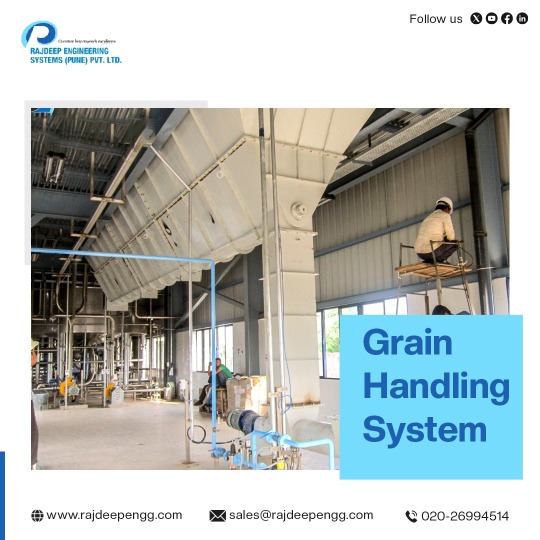
Grain handling systems play a pivotal role in the agricultural industry, facilitating the efficient movement and storage of grains from farm to market. Grain handling systems encompass a range of equipment and processes designed to handle, transport, store, and process grains such as wheat, corn, barley, and rice. With the ever-growing demand for grains globally, optimizing grain management systems is crucial for maximizing productivity and minimizing losses.
At the heart of any grain management system lies the grain elevator, a vertical structure equipped with conveyor belts or buckets that lift grains from ground level to silos for storage. These elevators are essential for transferring grains between various stages of production, from harvesting to storage and distribution. Modern elevators employ advanced technology to streamline operations and ensure the gentle handling of grains to prevent damage and maintain quality.
Conveyors are another integral component of grain handling systems, offering a flexible and efficient means of transporting grains within facilities. Belt conveyors, screw conveyors, and pneumatic conveyors are commonly used to move grains horizontally or vertically, allowing for seamless integration with other processing equipment. By automating the transport process, conveyors enhance productivity while reducing labor costs and the risk of manual errors.
Storage is a critical aspect of grain handling systems, influencing the quality and shelf life of grains. Silos are the primary storage structures, capable of holding large quantities of grains in a controlled environment. Equipped with ventilation systems and temperature monitoring devices, silos ensure optimal conditions to prevent spoilage caused by moisture and pests. Additionally, modern silos are designed for easy loading and unloading, facilitating quick turnaround times during peak harvest seasons.
Grain drying is another essential function performed within grain handling systems to reduce moisture content and preserve quality. Drying bins or towers utilize heated air or natural airflow to remove excess moisture from freshly harvested grains, preventing mold growth and ensuring safe storage. By expediting the drying process, these systems enable farmers to harvest grains at the optimal moisture level, maximizing yields and profitability.
In recent years, automation and digitalization have revolutionized grain handling systems, offering real-time monitoring and control capabilities. Advanced sensors and software systems allow operators to remotely manage equipment, monitor grain conditions, and optimize workflow efficiency. Predictive analytics and machine learning algorithms provide valuable insights into grain quality and storage conditions, enabling proactive maintenance and decision-making.
In conclusion, grain handling systems are indispensable assets for the agricultural industry, facilitating the efficient movement, storage, and processing of grains. By embracing technological advancements and best practices, farmers and grain handlers can optimize operations, minimize losses, and meet the growing demand for grains worldwide.
#Grain Handling System#Grain Management System#Rajdeep Engineering Systems#Industries Plantation and Machinery
0 notes